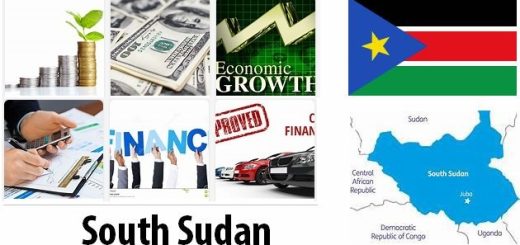Seychelles Economy Facts
Economical overview
Seychelles is a rich country compared to many other African countries. As the only sub-Saharan country, Seychelles is placed in the “very high human development” category by the UN agency UNDP.
The economy is mainly based on tourism and fishing. The island nation is also an important financial center. Tourism is of the greatest economic importance because it creates many jobs and affects other sectors, such as the construction industry and transport as well as banking and retail.
- Countryaah.com: Major imports by Seychelles, covering a full list of top products imported by the country and trade value for each product category.
Calculated in income per inhabitant, Seychelles has had a favorable economic development since independence in 1976. Gross domestic product (GDP) per inhabitant more than ninefold by 2005. After a sharp economic downturn with negative growth around the turn of the millennium, the economy began to recover in 2006. The global economic crisis 2008 led to a payment crisis in Seychelles as tourist income fell. An extensive reform program and support from the International Monetary Fund (IMF) has subsequently contributed to a substantial upswing.
Distinct tourist country
Tourism accounts for about a quarter of GDP and accounts for more than two-thirds of the country’s foreign currency revenue. One problem, however, is that over 60 percent of tourism revenue is used to pay for the import goods and services that the industry requires.
The number of tourists fell as a result of the terrorist attacks against the United States in 2001 and the tsunami in the Indian Ocean in 2004, but a few years later the Seychelles tourism industry was back on its feet. In 2013, the number of tourists increased by more than 10 percent compared to the previous year. In 2013, the number of visitors exceeded 230,000, even though the government set a maximum of 200,000 tourists per year to protect the environment. Since then, the number of tourists has continued to increase to almost 350,000 in 2017 (see Tourism).
- Abbreviationfinder.org: Check this abbreviation website to find three letter ISO codes for all countries in the world, including SYC which represents the country of Seychelles. Check findjobdescriptions to learn more about Seychelles.
The fishery, mainly canned tuna, accounted for almost 90 percent of the country’s goods exports in 2017. It also provides revenue from the sale of fishing licenses to foreign vessels.
Financial center
The Seychelles has a financial center with thousands of international companies attracted to the islands with tax exemption and banking secrecy. The financial sector has grown sharply since 2002, when the Western Cooperation Organization OECD removed Seychelles from its black list of countries suspected of money laundering.
The export-promoting industrial zone that was created in 1995 has not had much significance for the country’s economy (see Industry).
Since the introduction of multi-party systems in 1993, the economy has been liberalized. A number of state-owned companies have been privatized and the government plans to sell even more companies. A new investment law from 2005 has meant that foreign investment has increased significantly. The same year, the government gave the central bank greater independence. In 2006, Parliament passed a new, more liberal, labor market law, which, among other things, increased opportunities for employers to require their employees to work overtime.
In 2009, the government launched a large tax reform, with, among other things, increased the profit threshold for when companies have to start paying tax and reduced employer contributions to social insurance for low-income people. The following year, an income tax for workers of almost 19 percent was introduced.
Fixed exchange rate abolished
A major problem for the economy was for a long time the lack of foreign currency, which was largely due to an excessively high exchange rate for the rupee, which among other things led to widespread black exchange. In the black market, the value of the rupee was often twice as high as the official exchange rate. The high exchange rate made it difficult for companies to expand and discouraged companies from investing in the country. The International Monetary Fund (IMF) lent pressure for Seychelles to release the fixed exchange rate and refused to enter into an agreement with the country on, for example, debt write-offs due to the overvalued rupee. Despite concerns about rapid price increases, the government decided in 2006 to abolish the fixed exchange rate against the US dollar. The rupee fell in value against the dollar, the euro and the British pound. inflation,
The central government had a large budget deficit for a long time, which was mainly covered by domestic loans. A few years into the 2000s, deficits began to decline and since 2010 a budget surplus has been noted.
Given Seychelles’ high GDP per capita, the country is not a priority beneficiary. Assistance has been steadily declining since the early 1990s and was $ 37 million in 2012. Important donors are France, the UK and other EU countries, as well as the World Bank and the African Development Bank (ADB). Despite amortization of debt, total external debt has increased slightly in recent years, from USD 1.4 billion in 2010 to USD 1.8 billion in 2013.
Successful economic reforms
The international financial crisis, which struck in early 2008, hit the Seychelles tourism industry. Already in September that year, the number of visitors had decreased by 11 percent. The government announced in October that it was unable to pay its debts. Negotiations on how to resolve the crisis began with the IMF. The government called for a tenth of the civil servants to resign in order for the state to save money. In November, the IMF promised support of the equivalent of $ 26 million over two years, in exchange for, among other things, the government limiting the state’s role in the economy and taking measures to promote the private sector.
In 2010, the economy began to grow again, thanks in large part to increased tourism revenues. According to a report by the IMF in May that year, a number of reforms, such as a new tax system and better control of government finances, had contributed to the growth. The economy continued to grow at a good pace between 2011 and 2014, mainly due to the growing tourist flow.
FACTS – FINANCE
GDP per person
US $ 16,434 (2018)
Total GDP
US $ 1,590 million (2018)
GDP growth
3.6 percent (2018)
Agriculture’s share of GDP
2.0 percent (2018)
Manufacturing industry’s share of GDP
6.4 percent (2018)
The service sector’s share of GDP
70.4 percent (2018)
Inflation
2.0 percent (2019)
Government debt’s share of GDP
56.9 percent (2018)
Currency
Seychelles Rupee
Merchandise exports
US $ 562 million (2018)
Imports
US $ 1,234 million (2018)
Current account
– US $ 269 million (2018)
Commodity trade’s share of GDP
117 percent (2018)
Main export goods
canned tuna, re-export of oil products
Largest trading partner
France, United Kingdom, United Arab Emirates, Italy, Spain (2012)













